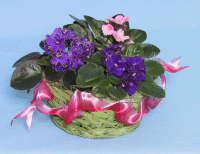African violets are the most popular houseplants in America, period. Enduring symbols of friendship and faithfulness, African violets have seemingly been around forever. Many of us have nostalgic memories of the African violets that always grew on our grandmothers’ windowsills, charming us with their fuzzy leaves and their perky blooms in shades of blue, purple, and pink. In Grandmother’s day, there weren’t all that many varieties African violets to choose from. She might be surprised to learn that today, there are more than 14,000 different named African violet hybrids!
And while that number may seem mind-boggling for most of us, to a real African violet enthusiast, the possibilities are endless. There’s always another new combination of blossom color, petal shape, flower size, foliage texture, or leaf outline to be discovered among the millions of seedlings that African violet hybridizers create every year.

African Violet Basket
The first African violets were discovered in 1890 by Baron Walter von Saint Paul, a German explorer who found them growing in the crevices of rocks in East Africa, in what is now known as Tanzania. He sent some of the plants back home to his father, who gave them their botanical name, Saintpaulia ionantha (which in Latin means “with violet flowers”). It wasn’t until 1920 that the African violet was introduced in the United States, but because it requires a warm atmosphere (between 65-75°) it did not become a popular houseplant until central heating was installed in households. More than 20 species of African violets have since been discovered, and hybridizers have had a field day crossing from these original species to develop the thousands of varieties we enjoy today.
African violet hybridizers and fanciers delight in the minute details of the plants. For example, blossoms are categorized by several different characteristics, including:
- number of petals: single, semi-double, or double
- shape: star-shaped, bell-shaped, wasp (narrow petals), etc.
- edge: fringed, rippled, different color, etc.
- markings: chimera (striped), fantasy (splotched or streaked), etc.
- color: two-tone, multicolor, etc.
Some of the defining features of African violet foliage include:
shape: pointed, ovate, spoon, spider (elongated), etc.
edge: scalloped, crested, ruffled, fringed, tailored, etc.
texture: quilted, supreme (thick and hairy), etc.
markings: variegated, crown, mosaic, etc.
As you can imagine, the possible combinations of African violet characteristics are practically endless. And although blues, purples, pinks and whites still dominate the color selection, there are African violets available today in shades of red, yellow, and even green. A true orange seems to be the color that is still elusive to African violet breeders.
African violet care is fairly easy. In general, soil should be kept moist but never soggy. Avoid getting water in the leaves or letting water settle in the crown or center of the plant, which can quickly lead to rotting. Use room temperature water. Some African violet growers use a wicking system for watering their plants, placing the pots upon a mat of absorbent material that’s kept moist. This process allows the plants to draw water up from the bottom. Allow for some air movement around the plants at all times to prevent mold or fungus diseases.
African violet plants grow best in bright shade. A north-facing window is usually ideal; the plants can receive bright light without direct sun, which can bleach or burn the leaves. It is important that African violets receive at least eight hours of darkness each night in order to promote blooming. Even the light from a lamp or an overhead fixture can disrupt this cycle, known as the “photo period” (the daily amount of light and darkness required to initiate flowering). Many enthusiasts prefer to grow their African violets under lights, allowing them to maintain absolute control over the amount and quality of light their plants receive.
Feed your African violets regularly with a “balanced” fertilizer, one in which the three numbers on the label (that represent the available amounts of nitrogen, phosphorous, and potash, respectively) are equal or nearly so. Follow the directions on the package as to the frequency of application. It’s important to avoid over-feeding, because it can cause cracked leaves and will actually impede flowering. Be certain that the fertilizer you use is 100% water soluble, which allows it to be fully utilized by your African violet plants. Its also a good idea to periodically leach the soil in the pot by pouring water through the soil until it runs out the drainage holes. This process helps to eliminate the buildup of fertilizer salts that can damage the African violet’s tender feeder roots.
For more information about African violets, visit the website of The African Violet Society of America or AboutFlowers.com. Also, check with your area botanical garden to see if there is a local group of African violet fanciers whose meetings you might attend. Whether you’re adding to your own collection or sending an African violet plant to someone locally or out of town, your neighborhood florist is a valuable local source for discovering some of the new African violet varieties. And if you’ve never tried growing African violets, maybe now is the time to start. They’re not just for grandmothers after all.


 Find Your
Find Your 


